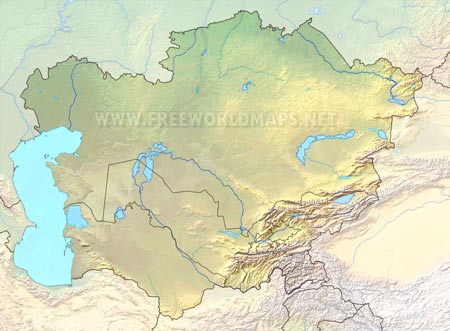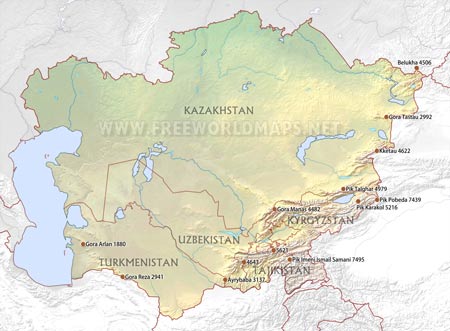The region called Central Asia is a landlocked territory comprising of the five currently independent countries that belonged to the former Soviet Union during the second part of the XX. Century. The landscapes of Central Asia map is extremely contrasted, ranging from one of the highest mountain chain of the world to dry deserts, arid lowlands, endless steppes and depressions lying below sea level.
The two southeastern countries of the region, Kyrgyzstan and Tajikistan host sky-scraping mountain ranges, like the Tian Shan, or the Pamirs, which rise above 7000 meter, the highest of those is the Ismoil Somoni Peak (Pik Imeni Ismail Samani), just short of the 7500 mark, found in central Tajikistan within the Pamirs chains. Kyrgyzstan also has peaks reaching 7000 meters, Jengish Chokusu or Pik Pobeda is the highest reaching 7439 meters, the highest in the Tian Shan range at the eastern tip of the country.
As we move westwards on the Central Asia map, the landscape becomes flatter, the other three countries geographical features are mainly steppes, deserts or lowlands. The Caspian Sea marks the western border of the region, which is the largest of the world's lakes. The sandy Turan Lowland lies to the east of the Caspian Sea, shared by all three countries, Kazakhstan, Turkmenistan and Uzbekistan. The arid lowland is surrounded by even drier deserts, like the Kyzylkum or the Karakum deserts.
The dominant rivers in this southern regions are the Amu Darya and Syr Darya rivers, both feed Lake Aral, one of the largest lakes of the world earlier. Due to irresponsible irrigation in the area, the lake has shrunk to 10% of its earlier size, and split into more smaller lakes. Lake Balkhash in eastern Kazakhstan is another endorheic lake. It is also one of the largest lakes in Asia, and is diminishing continuously like Lake Aral.
The Irtysh River flows through the northeastern section of Kazakhstan originating on the southern slopes of the Altai mountain system, draining towards the Arctic Ocean after joining the Ob river in Russia.








